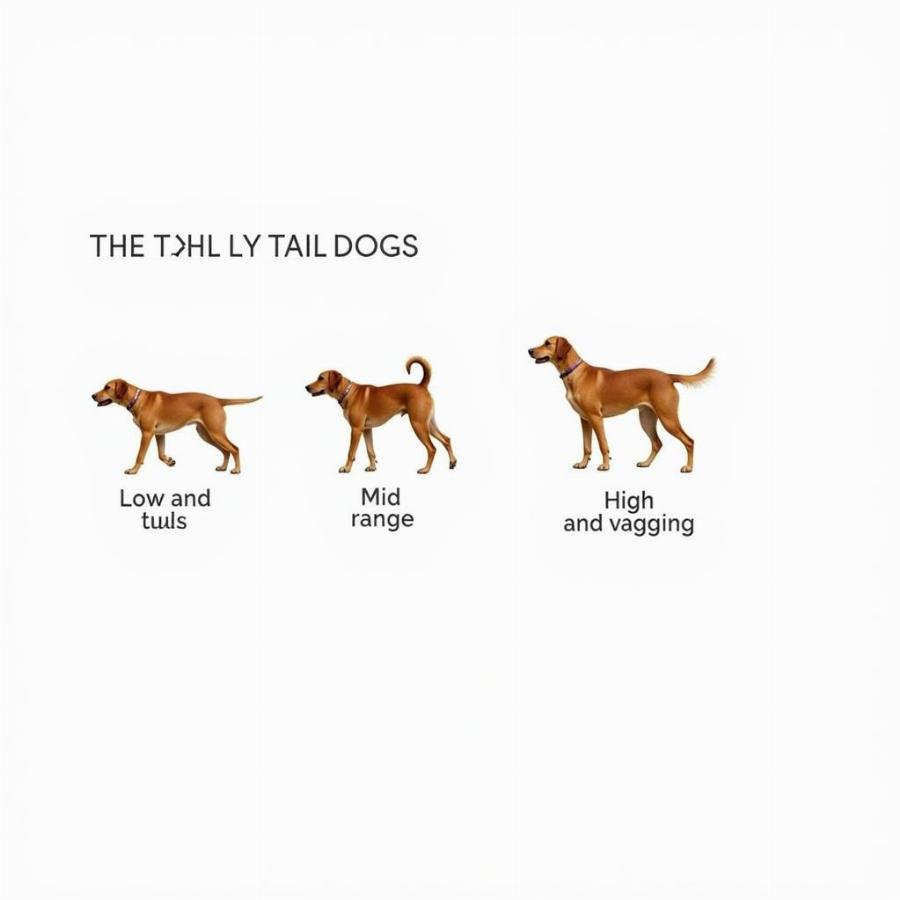A dog’s tail isn’t just an adorable appendage; it’s a powerful communication tool. While most people associate a wagging tail with happiness, the truth is canine body language is much more nuanced than that. So, what does it mean when a dog’s tail is down?
While a lowered tail can sometimes indicate a physical issue, more often than not, it’s a key indicator of your furry friend’s emotional state. Understanding the subtle signals your dog sends with their tail can help you build a stronger bond and ensure you’re meeting their needs.
Tail Position and What It Reveals
A dog’s tail position, coupled with other body language cues, can reveal a wealth of information about how they’re feeling.
Low or Tucked Tail: A tail held low, often tucked between the legs, generally signals fear, anxiety, or submission. This posture makes the dog appear smaller, minimizing the potential for a perceived threat.
Mid-range Tail Wag: Contrary to popular belief, not all tail wags are created equal. A mid-range wag, especially if it’s slow or hesitant, can indicate insecurity, uncertainty, or even a warning to back off.
High and Wagging Tail: This is the classic sign of a happy and confident dog. However, it’s crucial to consider the context. A high, rigid wag can sometimes indicate excitement that borders on aggression, especially when accompanied by other tense body language.
 Dog Tail Positions
Dog Tail Positions
Common Reasons for a Downward Tail
Now that we’ve explored the general meaning of a lowered tail let’s delve into some specific reasons why your canine companion might be sporting this posture:
1. Fear or Anxiety: This is the most common reason for a tucked tail. Loud noises, unfamiliar people or animals, and stressful situations can all trigger a fear response in dogs.
Example: Imagine taking your dog to a bustling park for the first time. The overwhelming sights, sounds, and smells could easily cause them to lower their tail and seek comfort by your side.
2. Submission or Appeasement: Dogs use a lowered tail to show deference to other dogs or humans they perceive as dominant. This behavior is a way of saying, “I’m not a threat.”
3. Illness or Injury: If your dog’s tail is suddenly down, and they’re displaying other unusual behaviors like lethargy, loss of appetite, or whimpering, it’s essential to rule out any medical concerns with a visit to the veterinarian.
4. Breed-Specific Traits: It’s worth noting that some breeds, like Greyhounds and Whippets, naturally carry their tails low.
Responding to Your Dog’s Tail Signals
Learning to read your dog’s tail language is crucial for effective communication and building a trusting relationship. Here are some tips:
- Consider the Context: Don’t just focus on the tail; observe your dog’s overall body language.
- Avoid Punishing Fear: Never scold or punish your dog for displaying fearful behavior, as this can worsen their anxiety.
- Positive Reinforcement: Reward confident and relaxed behavior with praise, treats, or a favorite toy.
- Consult a Professional: If you’re struggling to interpret your dog’s behavior or address fear-related issues, seek guidance from a certified dog trainer or behaviorist.
Understanding Your Furry Friend
By paying close attention to your dog’s tail language, you’ll gain valuable insights into their emotional state and strengthen the bond you share. Remember, every wag, tuck, and wiggle tells a story.
FAQs
Q: My dog wags their tail when they’re scared. Does this mean they’re happy?
A: Not necessarily. While tail wagging is often associated with happiness, it can also be a sign of anxiety or appeasement. Pay attention to the speed, position, and other body language cues accompanying the wag to get a clearer understanding.
Q: Why does my dog tuck their tail when I come home?
A: Your dog might be showing submissive behavior, especially if they’ve been home alone and are excited to see you.
Q: When should I be concerned about a sudden change in my dog’s tail carriage?
A: If your dog’s tail position changes suddenly and is accompanied by other behavioral or physical changes, it’s essential to contact your veterinarian.
Explore More About Canine Behavior
About Beaut Dogs
Beaut Dogs is your trusted source for all things dog-related. We’re dedicated to providing you with insightful and reliable information to help you understand and care for your canine companion better. For personalized advice and support, reach out to us at [email protected].